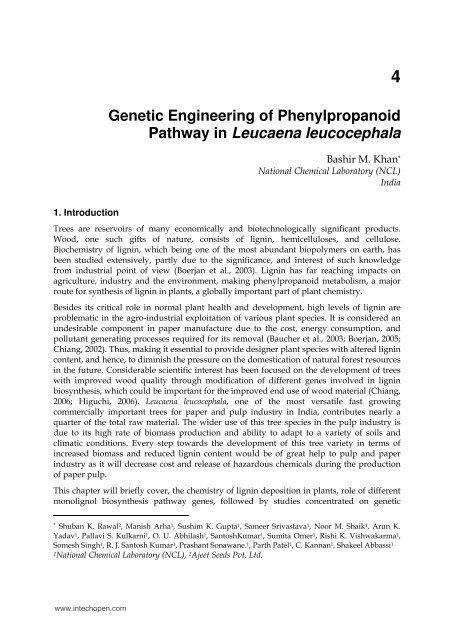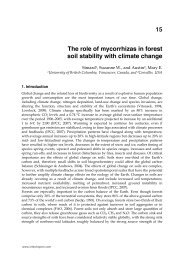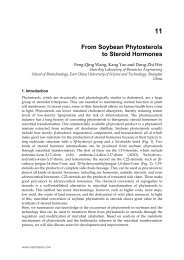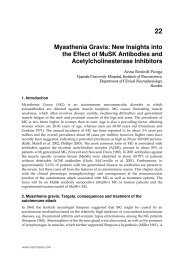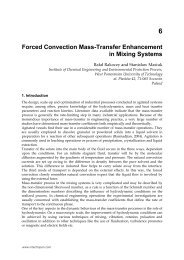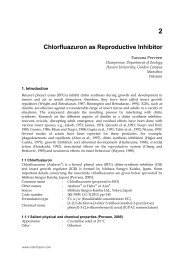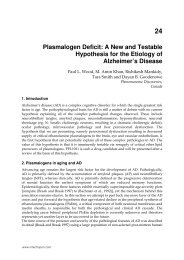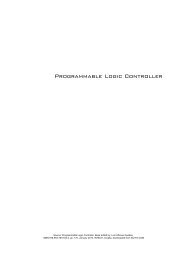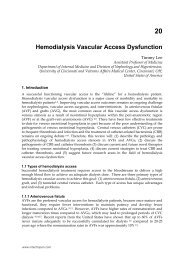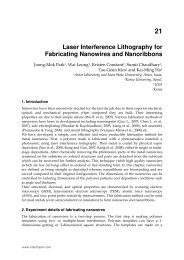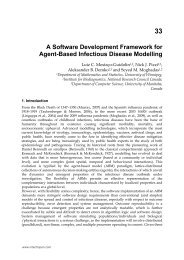Download as PDF - InTech
Download as PDF - InTech
Download as PDF - InTech
You also want an ePaper? Increase the reach of your titles
YUMPU automatically turns print PDFs into web optimized ePapers that Google loves.
1. Introduction<br />
Genetic Engineering of Phenylpropanoid<br />
Pathway in Leucaena leucocephala<br />
4<br />
B<strong>as</strong>hir M. Khan *<br />
National Chemical Laboratory (NCL)<br />
India<br />
Trees are reservoirs of many economically and biotechnologically significant products.<br />
Wood, one such gifts of nature, consists of lignin, hemicelluloses, and cellulose.<br />
Biochemistry of lignin, which being one of the most abundant biopolymers on earth, h<strong>as</strong><br />
been studied extensively, partly due to the significance, and interest of such knowledge<br />
from industrial point of view (Boerjan et al., 2003). Lignin h<strong>as</strong> far reaching impacts on<br />
agriculture, industry and the environment, making phenylpropanoid metabolism, a major<br />
route for synthesis of lignin in plants, a globally important part of plant chemistry.<br />
Besides its critical role in normal plant health and development, high levels of lignin are<br />
problematic in the agro-industrial exploitation of various plant species. It is considered an<br />
undesirable component in paper manufacture due to the cost, energy consumption, and<br />
pollutant generating processes required for its removal (Baucher et al., 2003; Boerjan, 2005;<br />
Chiang, 2002). Thus, making it essential to provide designer plant species with altered lignin<br />
content, and hence, to diminish the pressure on the domestication of natural forest resources<br />
in the future. Considerable scientific interest h<strong>as</strong> been focused on the development of trees<br />
with improved wood quality through modification of different genes involved in lignin<br />
biosynthesis, which could be important for the improved end use of wood material (Chiang,<br />
2006; Higuchi, 2006). Leucaena leucocephala, one of the most versatile f<strong>as</strong>t growing<br />
commercially important trees for paper and pulp industry in India, contributes nearly a<br />
quarter of the total raw material. The wider use of this tree species in the pulp industry is<br />
due to its high rate of biom<strong>as</strong>s production and ability to adapt to a variety of soils and<br />
climatic conditions. Every step towards the development of this tree variety in terms of<br />
incre<strong>as</strong>ed biom<strong>as</strong>s and reduced lignin content would be of great help to pulp and paper<br />
industry <strong>as</strong> it will decre<strong>as</strong>e cost and rele<strong>as</strong>e of hazardous chemicals during the production<br />
of paper pulp.<br />
This chapter will briefly cover, the chemistry of lignin deposition in plants, role of different<br />
monolignol biosynthesis pathway genes, followed by studies concentrated on genetic<br />
* Shuban K. Rawal 2, Manish Arha 1, Sushim K. Gupta 1, Sameer Sriv<strong>as</strong>tava 1, Noor M. Shaik 1, Arun K.<br />
Yadav 1, Pallavi S. Kulkarni 1, O. U. Abhil<strong>as</strong>h 1, SantoshKumar 1, Sumita Omer 1, Rishi K. Vishwakarma 1,<br />
Somesh Singh 1, R. J. Santosh Kumar 1, Pr<strong>as</strong>hant Sonawane. 1, Parth Patel 1, C. Kannan 1, Shakeel Abb<strong>as</strong>si 1<br />
1National Chemical Laboratory (NCL), 2Ajeet Seeds Pvt. Ltd.<br />
www.intechopen.com
94<br />
Genetic Engineering – B<strong>as</strong>ics, New Applications and Responsibilities<br />
engineering of phenylpropanoid pathway in Leucaena leucocephala <strong>as</strong> tool for altering its<br />
lignin composition, thereby its application in pulp and paper industries.<br />
2. Lignin: Occurrence, structure and function<br />
Lignin (from Latin lignum meaning wood), is one of the most abundant natural organic<br />
polymer next only to cellulose (Boerjan et al., 2003). It is a vital cell wall component of all<br />
v<strong>as</strong>cular plants and represents on an average of 25 % of the terrestrial biom<strong>as</strong>s. It plays<br />
crucial role in structural integrity of cell wall & stiffness and strength of stem (Chabannes et<br />
al., 2001; Jones et al., 2001). Lignin is primarily synthesized and deposited in the secondary<br />
cell wall of specialized cells such <strong>as</strong> xylem vessels, tracheids and fibers. It is also deposited<br />
in minor amounts in the periderm where <strong>as</strong>sociation with suberin provides a protective role<br />
against pathogens. In addition, lignin waterproofs the cell wall; enabling transport of water<br />
and solutes through the v<strong>as</strong>cular system (Sarkanen & Ludwig, 1971). Lignins are complex<br />
racemic aromatic heteropolymers synthesized from the dehydrogenative polymerization of<br />
monolignols, namely coumaryl, coniferyl and sinapyl alcohol monomers differing in their<br />
degree of methoxylation (Freudenberg & Neish, 1968). These monolignols produce<br />
respectively, p-hydroxyphenyl (H), guaiacyl (G) and syringyl (S) phenylpropanoid units<br />
when incorporated into the lignin polymer (Fig. 1). The amount and composition of lignins<br />
vary among taxa, cell types and individual cell wall layer, and are influenced by<br />
developmental and environmental cues (Campbell & Sederoff, 1996). Lignin content is<br />
higher in softwoods (27-33%) than in hardwood (18-25%) and gr<strong>as</strong>ses (17-24%). The highest<br />
amounts of lignin (35-40%) occur in compression wood on the lower part of branches and<br />
leaning stems (Sarkanen & Ludwig, 1971).<br />
Fig. 1. Structure of a lignin oligomer. These structures consist of phenylpropanoid units H,<br />
G and S. A number of such oligomers cross-polymerizes to form a complex structure of<br />
lignin<br />
www.intechopen.com
Genetic Engineering of Phenylpropanoid Pathway in Leucaena leucocephala<br />
2.1 Lignin biosynthesis<br />
Although lignin h<strong>as</strong> been studied for over a century, many <strong>as</strong>pects of its biosynthesis still<br />
remain unresolved. The monolignol biosynthetic pathway h<strong>as</strong> been redrawn many times,<br />
yet still remains a matter of debate. During the l<strong>as</strong>t two decades, significant headway h<strong>as</strong><br />
been made in isolating and characterizing a number of genes pertaining to monolignol<br />
biosynthesis from different plants. Several reviews on the advancements of monolignol<br />
biosynthesis pathways are also available (Boerjan et al., 2003; Humphreys & Chapple, 2002;<br />
Whetten & Sederoff, 1995; Whetten et al., 1998).<br />
In plants, lignins are synthesized by the polymerization of monolignols, namely p-coumaryl,<br />
coniferyl and sinapyl alcohol monomers differing in their degree of methoxylation (Higuchi,<br />
1985; Sederoff & Chang, 1991) via phenylpropanoid biosynthetic pathway (Gross, 1985).<br />
This pathway comprises a complex series of branching biochemical reactions responsible for<br />
synthesis of a variety of products like lignin, flavonoids and hydroxycinnamic acid<br />
conjugates. Many intermediates and end products of this pathway play important role in<br />
plant such <strong>as</strong> phytoalexins, antiherbivory compounds, antioxidants, ultra violet (UV)<br />
protectants, pigments and aroma compounds. Finally, the diverse functions of lignin and<br />
related products in resistance to biotic and abiotic stresses make this pathway vital to the<br />
health and survival of plants.<br />
The synthesis of lignin represents one of the most energy demanding biosynthetic pathways<br />
in plants, requiring large quantities of carbon skeletons. Deposition of lignin in plants<br />
proceeds via the following steps:<br />
1. The biosynthesis of monolignols<br />
2. Transport of monolignols from the site of synthesis to the site of polymerization<br />
3. Dehydrogenation & Polymerization of monolignols.<br />
2.1.1 Biosynthesis of monolignols<br />
The biosynthesis of monolignols proceeds through the phenylpropanoid pathway starting<br />
with deamination of phenylalanine to produce cinnamic acid and involves successive<br />
hydroxylation reactions of the aromatic ring, followed by phenolic o-methylation and<br />
conversion of the side chain carboxyl to an alcohol group (Fig. 2). Immense amount of work<br />
h<strong>as</strong> been done in characterizing the monolignol biosynthesis pathway in p<strong>as</strong>t two decades.<br />
It is a complex pathway comprising of enzymes with functions like methyltransfer<strong>as</strong>e,<br />
hydroxyl<strong>as</strong>e, reduct<strong>as</strong>e and dehydrogen<strong>as</strong>e. Some of the important enzymes involved in<br />
monolignol biosynthesis have been discussed below.<br />
2.1.1.1 Phenylalanine ammonia-ly<strong>as</strong>e (PAL)<br />
The enzyme phenylalanine ammonia-ly<strong>as</strong>e (PAL; EC: 4.3.1.5) that catalyzes the conversion<br />
of phenylalanine to transcinnamic acid, is the initial step towards monolignol biosynthesis<br />
and other phenolic secondary plant metabolites. Genes encoding PAL have been studied in<br />
Populus species (Kao et al. 2002; Osakabe et al., 1995), loblolly pine and other plant species<br />
(Bate et al., 1994; Hatton et al., 1995; Jones, 1984; Kumar & Ellis, 2001; Leyva et al., 1992; Ohl<br />
et al., 1990). PAL exists <strong>as</strong> a multiple member gene family and the individual members can<br />
be involved in different metabolic pathways <strong>as</strong> suggested by their expression patterns in<br />
<strong>as</strong>sociation with certain secondary compounds accumulated in specific tissue or<br />
www.intechopen.com<br />
95
96<br />
Genetic Engineering – B<strong>as</strong>ics, New Applications and Responsibilities<br />
Fig. 2. An overview of monolignol biosynthesis pathway: PAL, Phenylalanine ammonialy<strong>as</strong>e;<br />
C4H, Cinnamic acid 4-hydroxyl<strong>as</strong>e; C3H, p-Coumarate 3-hydroxyl<strong>as</strong>e; HCT,<br />
Hydroxycinnamoyltransfer<strong>as</strong>e; 4CL, 4-Coumarate-CoA lig<strong>as</strong>e; CCoAOMT, Caffeoyl-CoA Omethyltransfer<strong>as</strong>e;<br />
CCR, Cinnamoyl CoA reduct<strong>as</strong>e; CAld5H, Coniferyl aldehyde 5hydroxyl<strong>as</strong>e;<br />
AldOMT, 5- hydroxyconiferyl aldehyde O-methyltransfer<strong>as</strong>e; CAD, Cinnamyl<br />
alcohol dehydrogen<strong>as</strong>e; SAD, Sinapyl alcohol dehydrogen<strong>as</strong>e<br />
www.intechopen.com
Genetic Engineering of Phenylpropanoid Pathway in Leucaena leucocephala<br />
developmental stage. The biochemical activity of all known PALs is verified <strong>as</strong> specific<br />
deamination of phenylalanine, but genetic and physiological function may vary among<br />
different PAL members. The expression of PAL genetic function is controlled by various<br />
genetic circuits and signaling pathways.<br />
2.1.1.2 Cinnamate 4-Hydroxyl<strong>as</strong>e (C4H)<br />
C4H (EC: 1.14.13.11) constitutes the CYP73 family of the large group of Cyt P450<br />
monooxygen<strong>as</strong>es. It catalyzes the 4-hydroxylation of trans-cinnamate, the central step in the<br />
generation of phenylalanine-derived substrates for the many branches of phenylpropanoid<br />
metabolism. The first and the l<strong>as</strong>t enzymes of this short sequence of closely related reactions,<br />
termed the general phenylpropanoid metabolism, are PAL and 4CL, respectively. A second<br />
metabolic link couples C4H to the membrane-localized Cyt P450 Reduct<strong>as</strong>e (CPR). The<br />
expression patterns of all three C4H-linked enzymes, PAL, 4CL, and CPR, and of the<br />
corresponding mRNAs have been analyzed in cell-suspension cultures and various intact<br />
tissues of parsley (Logemann et al., 1995) and Arabidopsis (Mizutani and Ohta, 1997). A<br />
reduction in PAL levels leads to an incre<strong>as</strong>e in the S/G ratio, where<strong>as</strong> reduced C4H activity<br />
leads to a decre<strong>as</strong>e in the S/G ratio. These observations support the existence of some sort of<br />
metabolic channeling between the enzymes of the central phenylpropanoid pathway and<br />
those of monolignol biosynthesis and also provide a b<strong>as</strong>is for the development of new<br />
strategies for modified or reduced lignin content.<br />
Similar to PAL, C4H is thought to be involved in a number of secondary metabolism<br />
pathways in addition to monolignol biosynthesis <strong>as</strong> p-coumarate is an intermediate for<br />
biosynthesis of many secondary compounds (Croteau et al., 2000). Multiple C4H gene<br />
members are identified in many plant species, however, only one C4H is known in the<br />
Arabidopsis genome (Raes et al., 2003). The expression study of two C4H members in<br />
quaking <strong>as</strong>pen indicated that one is strongly expressed in developing xylem tissues and the<br />
other is more active in leaf and young shoot tissues (Shanfa et al., 2006). In other species,<br />
C4H gene is expressed in a variety of tissues and the expression is induced by wounding,<br />
light, pathogen attacks and other biotic & abiotic stimuli (Bell-Lelong et al., 1997; Raes et al.,<br />
2003). The mechanisms that regulate the genetic function of C4H gene and its family<br />
members are yet unknown.<br />
2.1.1.3 Coumarate 3-hydroxyl<strong>as</strong>e (C3H)<br />
Early biochemical evidence suggested that conversion of coumarate to caffeate is catalyzed<br />
by a nonspecific phenol<strong>as</strong>e, but that suggestion did not receive much support in other<br />
studies (Boniwell & Butt, 1986; Kojima & Takeuchi, 1989; Petersen et al., 1999; Stafford &<br />
Dresler, 1972). The gene encoding p-coumarate 3-hydroxyl<strong>as</strong>e (C3H) w<strong>as</strong> cloned and an<br />
alternative pathway proposed b<strong>as</strong>ed on the enzyme activity of CYP98A3 gene from<br />
Arabidopsis (Franke et al., 2002 a; Nair et al., 2002; Schoch et al., 2001).<br />
2.1.1.4 p-hydroxycinnamoyl-CoA: quinate shikimate p-hydroxycinnamoyl- transfer<strong>as</strong>e<br />
(HCT)<br />
The enzyme p-coumarate 3-hydroxyl<strong>as</strong>e (C3H) converts p-coumaric acid into caffeic acid<br />
and h<strong>as</strong> been shown to be a cytochrome p450-depenedent monooxygen<strong>as</strong>e. It is interesting<br />
to note that enzymatic <strong>as</strong>says have demonstrated that the shikimate and quinate esters of<br />
p-coumaric acid are the preferred substrates for C3H over p-coumaric acid,<br />
p-coumaroyl-CoA, p coumaraldehyde, p-coumaryl alcohol, nor the 1–O-glucose ester and<br />
www.intechopen.com<br />
97
98<br />
Genetic Engineering – B<strong>as</strong>ics, New Applications and Responsibilities<br />
the 4–O-glucoside of p-coumaric acid are good substrates (Franke et al., 2002; Nair et al.,<br />
2002; Schoch et al., 2001). p-Coumarate is first converted to p-coumaroyl-CoA by 4CL, with<br />
subsequent conversion to p-coumaroyl-shikimate and p-coumaroyl-quinate, the substrates<br />
for C3H, by p-hydroxycinnamoyl-CoA:quinate-(CQT) or p-hydroxycinnamoyl-CoA:shikimate<br />
p-hydroxycinnamoyltransfer<strong>as</strong>e (CST) (Schoch et al., 2001). These enzymes, described <strong>as</strong><br />
reversible enzymes, can convert caffeoyl-shikimate or caffeoyl-quinate (chlorogenic acid)<br />
into caffeoyl-CoA, the substrate for CCoAOMT. A reversible acyltransfer<strong>as</strong>e with both CQT<br />
and CST activity, designated HCT, h<strong>as</strong> been purified and the corresponding gene cloned<br />
from tobacco (Hoffmann et al., 2002). Silencing of HCT through RNA interference (RNAi)<br />
lead to reduction in lignin, hyper accumulation of flavonoids and growth inhibition in<br />
Arabidopsis (Chapple, 2010; Hoffmann et al., 2004, 2007)<br />
2.1.1.5 Coumarate Coenzyme-A lig<strong>as</strong>e (4CL)<br />
Genetic and biochemical functions of 4-Coumarate Coenzyme A lig<strong>as</strong>e (4CL; EC: 6.2.1.12)<br />
genes have been clearly demonstrated in <strong>as</strong>sociation with monolignol biosynthesis (Lewis<br />
and Yamamoto, 1990; Lee et al., 1997; Hu et al., 1998, 1999; Harding et al., 2002). 4CL genes<br />
usually exist <strong>as</strong> a multi-gene family. Four 4CL genes were detected in the Arabidopsis<br />
genome and the expression of each member w<strong>as</strong> regulated differentially in tissues and<br />
development stages (Raes et al., 2003). In <strong>as</strong>pen trees, two 4CL genes were cloned and their<br />
expression were clearly distinct, with one in epidermal & leaf tissue and the other<br />
specifically in developing xylem tissue (Harding et al., 2002; Hu et al., 1998). Furthermore,<br />
the enzymatic activities of 4CL members from <strong>as</strong>pen, loblolly pine, tobacco, soybean,<br />
Arabidopsis, and many other species were found to have distinct substrate specificities (Hu et<br />
al., 1998; Lindermayr et al., 2003; Voo et al., 1995). Whether the substrate specificity of the<br />
4CL members relates to different metabolic pathways is unknown. As the 4CL catalytic<br />
kinetics vary among species, it is also likely that the mainstream pathway mediated by 4CL<br />
may not be exactly the same in all plant species or tissues. Nevertheless, monolignol<br />
biosynthesis is tightly controlled by 4CL.<br />
2.1.1.6 O-methyltransfer<strong>as</strong>es (O-MT)<br />
S-adenosyl-L-methionine methyltransfer<strong>as</strong>es are key enzymes in the phenylpropanoid,<br />
flavanoid and many other metabolic pathways in plants. The enzymes Caffeate 3-O<br />
methyltransfer<strong>as</strong>e (COMT; EC: 2.1.1.68) and Caffeoyl CoA 3-O methyltransfer<strong>as</strong>e<br />
(CCoAOMT; EC: 2.1.1.104) control the degree of methoxylation in lignin precursors i.e.<br />
p- hydroxyphenyl (H), guaiacyl (G) and syringyl (S) units of lignin (Higuchi, 1990; Ralph et<br />
al., 1998; Boerjan et al., 2003). The methylation reactions at the C3 and C5 hydroxyl functions<br />
of the lignin precursors were thought to occur mainly at the cinnamic acid level via a bifunctional<br />
COMT. However, the <strong>as</strong>sociation of CCoAOMT expression with lignification<br />
(Pakusch et al., 1991; Ye et al., 1994; Ye & Varner, 1995; Ye, 1997; Martz et al., 1998; Chen et<br />
al., 2000) and the observation that down-regulation of COMT preferentially affected the<br />
amount of S units suggested the existence of an alternative pathway for the methylation of<br />
the lignin precursors at the hydroxycinnamoyl CoA level and specific O-methyltransfer<strong>as</strong>e<br />
i.e. CCoAOMT converts caffeoyl CoA into feruloyl CoA and 5-hydroxyferuloyl CoA into<br />
sinapyl CoA (Martz et al., 1998).<br />
2.1.1.7 Cinnamoyl CoA reduct<strong>as</strong>e (CCR)<br />
The reduction of cinnamoyl CoA esters to cinnamaldehydes is the first metabolic step<br />
committed to monolignol formation (Lacombe & Hawkins, 1997). This first reductive step in<br />
www.intechopen.com
100<br />
Genetic Engineering – B<strong>as</strong>ics, New Applications and Responsibilities<br />
enzymatic activity h<strong>as</strong> specific affinity toward sinapaldehyde, therefore it w<strong>as</strong> named SAD.<br />
Compared with SAD enzyme kinetics, CAD showed a catalytic specificity towards<br />
coniferaldehyde instead. The catalytic specificities of the two enzymes have been further<br />
verified in protein structure analysis (Bomati & Noel, 2005). Furthermore, it w<strong>as</strong><br />
demonstrated that the expression of CAD is <strong>as</strong>sociated with G-lignin accumulation while<br />
SAD w<strong>as</strong> <strong>as</strong>sociated with S-lignin formation during xylem differentiation (Li et al., 2001).<br />
The evidence from molecular, biochemical and cellular characterizations strongly suggest<br />
that CAD is involved in G-monolignol biosynthesis and SAD in S-monolignol biosynthesis<br />
in <strong>as</strong>pen wood formation.<br />
2.1.2 Transport of monolignols<br />
After the synthesis, the lignin precursors or monolignols are transported to the cell wall<br />
where they are oxidized and polymerized. The monolignols formed are insoluble and toxic<br />
to the plant cell and hence are converted to their respective glucosides by the action of UDPglycosyltransfer<strong>as</strong>es<br />
(UDP-GT). This conversion renders the monolignols, soluble and less<br />
toxic to the plant cells, which can be stored in plant vacuoles, and transported to the cell<br />
wall <strong>as</strong> the need arises. It h<strong>as</strong> been hypothesized that these monolignol glucosides are<br />
storage or transport forms of the monolignols (Steeves et al., 2001).<br />
2.1.3 Dehydrogenation and polymerization<br />
After transport of the monolignols to the cell wall, lignin is formed through<br />
dehydrogenative polymerization of the monolignols (Christensen et al., 2000). The<br />
dehydrogenation of monolignol radicals h<strong>as</strong> been attributed to different cl<strong>as</strong>s of enzymes,<br />
such <strong>as</strong> peroxid<strong>as</strong>es (POX), lacc<strong>as</strong>es (LAC), polyphenol oxid<strong>as</strong>es, and coniferyl alcohol<br />
oxid<strong>as</strong>e. Lignin is a hydrophobic and optically inactive polymer, which is highly complex<br />
and heterogeneous in nature. Lignin polymerization is a radical coupling reaction, where<br />
the monolignols are first activated into phenoxy radicals in an enzyme catalyzed<br />
dehydrogenation reaction. These radicals couple to form dimers, oligomers and eventually<br />
the lignin polymer (Freudenberg, 1968). Peroxid<strong>as</strong>es are heme-containing oxidoreduct<strong>as</strong>es<br />
that use H2O2 <strong>as</strong> the ultimate electron acceptor. The natural electron donor molecules in a<br />
peroxid<strong>as</strong>e catalyzed reaction vary and include, monolignols, hydroxycinnamic acids<br />
(Zimmerlin et al., 1994), tyrosine residues in extensions (Brownleader et al., 1995) and auxin<br />
(Hinman & Lang, 1965). Several reports on peroxid<strong>as</strong>e activity or gene expression in ligninforming<br />
tissues have appeared, but only a few isoenzymes or genes have been specifically<br />
<strong>as</strong>sociated with lignification (Christensen et al., 2001; Marjamaa et al., 2006; Quiroga et al.,<br />
2000; Sato et al., 1993).<br />
2.2 Regulation of monolignol biosynthesis<br />
Developmental program of lignification <strong>as</strong>sociated with certain types of plant cells, such <strong>as</strong><br />
xylem and fibers, require coordinated regulation of different lignin biosynthesis genes, <strong>as</strong><br />
well <strong>as</strong> with genes controlling other <strong>as</strong>pects of plant growth and development. Different<br />
transcription factors such <strong>as</strong> R2R3-MYB, KNOX, MADS, LIM have been found to be<br />
regulating lignin biosynthesis in many plants, although the understanding of the molecular<br />
mechanism of pathway regulation is still limiting (Campbell & Rogers, 2004; Zhou et al.,<br />
2006, 2008). Lignification can be modified in a more efficient and precise way by<br />
www.intechopen.com
Genetic Engineering of Phenylpropanoid Pathway in Leucaena leucocephala<br />
understanding the regulation of these pathways via altering the expression of relevant<br />
transcription factors.<br />
3. Lignin <strong>as</strong> barrier for paper production<br />
From an agro-economical point of view, lignin is considered to have a negative impact<br />
because it affects the paper manufacture and limits digestibility of forage crops. High<br />
quantity and low Syringyl (S) to Guaiacyl (G) lignin ratio plays a detrimental role in<br />
economy and ecology of paper production. Every unit incre<strong>as</strong>e in S/G ratio decre<strong>as</strong>es the<br />
cost of paper production by two and half times. Both lignin content and composition are<br />
known to have impact on pulp & paper because residual lignin in the wood fibers causes a<br />
discoloration and a low brightness level of the pulp (Chaing et al., 1988). Consequently, for<br />
the production of high quality paper, lignin h<strong>as</strong> to be removed from cellulose during the<br />
pulping process without damaging the polysaccharide component of wood. During<br />
chemical (Kraft) pulping, a large amount of Sodium hydroxide (NaOH) and Sodium sulfide<br />
(Na2S) are required to extract lignin from the pulp (Axegard et al., 1992). Subsequently, the<br />
residual lignin is further removed with bleaching agents, such <strong>as</strong> Chlorine dioxide (ClO2),<br />
Hydrogen peroxide (H2O2), Sodium hypochlorite(NaOCl), Oxygen(O2), or Ozone (O3)<br />
(Axegard et al.,1992; Biermann, 1993; Christensen et al., 2000).<br />
These lignin extraction & bleaching procedures can partly degrade cellulose and<br />
consequently, reduce pulp quality and paper strength. Lignin extraction consumes large<br />
quantities of chemicals and energy leading to poor environmental image for these industries<br />
(Biermann, 1996; Higuchi, 1985; Odendahl, 1994). For this re<strong>as</strong>on, engineering of plants with<br />
cell wall structures that are more susceptible to the krafting, and thus, more amenable to<br />
hydrolysis, or are sufficiently altered so <strong>as</strong> to shunt the above processes is an attractive<br />
approach to improve pulping efficiency and potentially alleviate some of the negative<br />
environmental impacts of the paper making industry. Apart from the great deal of work in<br />
the lignin field for improving the pulping process, many examples can be found b<strong>as</strong>ed on<br />
research aimed at altering the lignin content for improving bio-fuel production (Chen, 2006;<br />
Chen & Dixion, 2007; Davision, 2006; Franke et al., 2002), <strong>as</strong> well <strong>as</strong> for improving forage<br />
crop digestibility (Table 1).<br />
4. Genetic engineering of phenylpropanoid biosynthetic pathway<br />
Despite the extensive literature on genetic modifications of lignin biosynthesis in a variety of<br />
plants, only a few studies have reported the impact of modified lignin content and<br />
composition on pulping and bleaching processes. Nevertheless, significant progress h<strong>as</strong><br />
been made in this field, <strong>as</strong> summarized in Table 1.<br />
Emerging genetic engineering strategies in planta including manipulation of lignin<br />
biosynthesis at regulatory level, controlling monolignol polymerization enzymes, and<br />
modifications of lignin polymer structure, together with exploration of lignin degrading<br />
enzymes from other organisms provide us the necessary tools for producing designer plant<br />
species with reduced/altered lignin traits, so <strong>as</strong> to meet the needs of paper, livestock<br />
industries, etc. However, traditional genetic engineering strategies such <strong>as</strong> upregulation and<br />
downregulation of monolignol biosynthetic genes are still applied and have been successful<br />
in facilitating lignin decomposition by altering both lignin content and composition. One<br />
www.intechopen.com<br />
101
Genetic Engineering of Phenylpropanoid Pathway in Leucaena leucocephala<br />
While these models will continue to serve <strong>as</strong> platforms for studying lignifications, a number<br />
of other plant species, e.g., Leucaena leucocephala have recently been selected for such studies.<br />
The paper industry in India mainly uses bamboos, Eucalyptus sp., C<strong>as</strong>uarina sp. and<br />
Leuacaena sp. <strong>as</strong> a source for paper pulp. Selection of the species depends upon availability,<br />
price and acceptability by any given industrial unit. However Leucaena sp. is extensively<br />
used in India and nearly a quarter of raw materials for paper and pulp industry comes from<br />
this plant (Sriv<strong>as</strong>tava et al., 2011). Leucaena is also valued <strong>as</strong> an excellent source of nutritious<br />
forage.<br />
(a) (b)<br />
Fig. 4. (a) Leucaena leucocephala cv. K-636 growing at NCL premises, (b) A transgenic plant<br />
cultivated in our green-house. (Photographs courtesy of Shakeel Abb<strong>as</strong>si, NCL)<br />
It h<strong>as</strong> been estimated that dried leaves of Leucaena contain nearly 28-35% of protein content<br />
of high nutritional quality. Besides this, Leuceana is also an excellent source of firewood,<br />
industrial fuel, organic fertilizer, timber and gum (Cottom et al., 1977). A native of Central<br />
America, Leucaena h<strong>as</strong> been naturalized pan-tropically, with members of its genera being<br />
vigorous, drought tolerant, highly palatable, high yielding & rich in protein and grow in<br />
wide range of soils (Hughes, 1998; Jones, 1979). However, these attributes are limited by the<br />
occurrence of anti-nutritive factors in the fodder, such <strong>as</strong> tannins and mimosine (Hammond<br />
et al., 1989; Hegarty et al., 1964; Jones, 1979).<br />
4.2 Phenylpropanoid biosynthesis genes from Leucaena leucocephala<br />
Different genes involved in phenylpropanoid biosynthesis were studied in detail from<br />
Leucaena. Table 2 summarizes the details of such genes isolated from Leucaena along with<br />
their GenBank accession numbers.<br />
4.3 Regeneration system of Leucaena leucocephala<br />
Genetic transformation of plants needs reproducible robust regeneration system.<br />
Regeneration of complete plants through tissue culture h<strong>as</strong> made it possible to introduce<br />
foreign genes in to plant genome and recover transgenic plants. The limited success rate for<br />
www.intechopen.com<br />
103
104<br />
Name of Genes Accession<br />
Nos.<br />
Genetic Engineering – B<strong>as</strong>ics, New Applications and Responsibilities<br />
cDNA,<br />
kb<br />
Amino<br />
acid no.<br />
Mm,<br />
kDa<br />
Annotations<br />
PAL JN540043* -- -- -- Ll-PAL<br />
C4H GU183363<br />
HQ191221<br />
HQ191222<br />
4CL FJ205490<br />
FJ205491*<br />
CCoAOMT DQ431234<br />
DQ431233<br />
CCR EU195224<br />
DQ986907<br />
1.836<br />
1.761<br />
1.760<br />
1.935<br />
1.831<br />
0.735<br />
0.735<br />
1.005<br />
1.011<br />
505<br />
505<br />
505<br />
542<br />
519<br />
244<br />
244<br />
334<br />
336<br />
57.94<br />
57.93<br />
57.99<br />
58.87<br />
56.74<br />
27.55<br />
27.57<br />
36.30<br />
36.52<br />
LlC4H1<br />
LlC4H2<br />
LlC4H3<br />
4CL 1<br />
4CL2<br />
CCoAOMT2<br />
CCoAOMT1<br />
Ll-CCRH2<br />
Ll-CCRH1<br />
CAld5H EU041752 1.826 511 57.42 Ll-Cald5H<br />
CAD EU870436 1.178 357 38.87 Ll-CAD<br />
Lignin POX GU143879<br />
GU143878<br />
EU649680<br />
0.951<br />
0.951<br />
0.951<br />
316<br />
316<br />
316<br />
33.94<br />
34.03<br />
34.20<br />
POX1<br />
POX2<br />
Ll-POX<br />
Glucosylhydrol<strong>as</strong>e EU328158 1.524 507 57.57 Ll-GH Family 1<br />
R2R3 MYB factor GU901209 0.911 235 26.50 Ll_R2R3_MYB2_SSM<br />
Cellulose<br />
Synth<strong>as</strong>e(CesA)<br />
FJ871987<br />
GQ267555<br />
3.391<br />
3.368<br />
1075<br />
1073<br />
123.30<br />
119.97<br />
Ll-7CesA<br />
Ll-8CesA<br />
Table 2. Phenylpropanoid biosynthesis genes from Leucaena: C4H: Cinnamate 4-Hydroxyl<strong>as</strong>e;<br />
4CL: 4 Coumarate CoA Lig<strong>as</strong>e; CCoAOMT: Caffeoyl CoA O-Methyl Transfer<strong>as</strong>e; COMT:<br />
Caffeate O-Methyl Transfer<strong>as</strong>e; CCR: Cinnamoyl CoA Reduct<strong>as</strong>e; CAld5H: Coniferaldehyde<br />
5-Hydroxyl<strong>as</strong>e; CAD: Cinnamyl Alcohol Dehydrogen<strong>as</strong>e; POX: Peroxid<strong>as</strong>e; *Partial<br />
sequence<br />
regeneration of leguminous trees h<strong>as</strong> been reported in few research works. The complete in<br />
vitro plantlet regeneration of Leucaena (Cultivar, K-67) from lateral bud explants h<strong>as</strong> been<br />
optimized with the maximum shoot multiplication rate of 22 shoots per explants. These<br />
regenerated plantlets were transplanted ex vitro with 80% survival rates (Goyal et al., 1985).<br />
In addition to the regeneration from lateral bud explants, an alternative (both direct and<br />
callus mediated/indirect) plantlet regeneration system h<strong>as</strong> been successfully demonstrated<br />
with 100% regeneration frequency using cotyledon explants from 3-4 days old plants<br />
(Cultivar, K-636). It is interesting to note that the plantlets regenerated from cotyledonary<br />
explants rooted without any requirements of growth regulators on b<strong>as</strong>al media (Saafi et al.,<br />
2002). Addition of Thidiazuron (TDZ) to the shoot induction medium h<strong>as</strong> substantially<br />
improved the number of in vitro shoots per explants <strong>as</strong> compared to the b<strong>as</strong>al shoot<br />
induction medium with N 6-Benzyladenine (BA). Liquid pulse treatment of the induced<br />
shoots with TDZ resulted in the improvement in the subsequent rooting. The plantlets<br />
regenerated in this manner showed more than 90% survival rate ex vitro when grown in<br />
coco-peat mixture (Shaik et al., 2009). In order to improve overall in vitro plantlet<br />
regeneration efficiency, attempts to propagate elite (cultivar K-8, K-636) and wild type<br />
varieties of Leucaena were made by supplementing the b<strong>as</strong>al shoot induction media with<br />
puterscin. It h<strong>as</strong> been observed that putriscine (9.3 µM) significantly enhanced the number<br />
of regenerated shoots from hypocotyls explants when compared to the induction medium<br />
containg only BA (22.2 µM). The incidence of yellowing and leaf abscission w<strong>as</strong> successfully<br />
www.intechopen.com
106<br />
Genetic Engineering – B<strong>as</strong>ics, New Applications and Responsibilities<br />
Leucaena plants for reduced/altered lignin content, various phenylpropanoid pathway genes<br />
(C4H, 4CL, CCoAoMT, CCR, CAld5H, CAD and POX) were cloned and used for<br />
transformation experiments.<br />
Fig. 5. In vitro shoot regeneration in L. leucocephala (cultivar K-636). A: Cotyledonary nodes,<br />
B-C: Multiple shoot induction in cotyledonary nodes on ½-MS + TDZ (0.23 µM), D:<br />
Shortened and f<strong>as</strong>ciated shoots of Leucaena on ½-MS + TDZ (0.45 µM), E: Rooted shoots of<br />
Leucaena on ½-MS + NAA (0.54 µM) and F: Hardened in vitro propagated plant of L.<br />
leucocephala in Sand: soil mixture. (Shaik et al., 2009)<br />
One day old embryo axes without cotyledons were used <strong>as</strong> explants for transformation. It<br />
w<strong>as</strong> carried out by three methods: 1) Particle bombardment; 2) Particle bombardment<br />
followed by co-cultivation and 3) Agro-infusion method. The transformation efficiencies<br />
with various gene constructs are summarized in Table 3. It can be observed that maximum<br />
efficiency (100%) w<strong>as</strong> noted with CAD using particle bombardment followed by cocultivation<br />
<strong>as</strong> a means of transformation. However, CCR with the same procedure gave only<br />
10% efficiency. In general it w<strong>as</strong> concluded that a combination of particle bombardment<br />
method followed by co-cultivation w<strong>as</strong> most effective in transforming the shoot meristems<br />
of Leucaena.<br />
www.intechopen.com
Genetic Engineering of Phenylpropanoid Pathway in Leucaena leucocephala<br />
Gene Method No. of<br />
embryo<br />
axis used<br />
No. of<br />
explants<br />
survived<br />
No. of shoots<br />
elongated<br />
Avg. shoot<br />
length*<br />
No. of shoots<br />
used for DNA<br />
extraction<br />
No. PCR<br />
+ve<br />
samples<br />
107<br />
Transformation<br />
efficiency (%)#<br />
CCR P B 67 59 30 3.67 8 4 50<br />
CCR PB + CC 107 94 40 2.97 20 2 10<br />
CCR A I 43 6 6 2.07 6 1 16.66<br />
4CL1 P B 231 205 154 3.72 154 92 59.74<br />
4CL1 PB + CC 109 83 47 3.41 47 38 80.85<br />
4CL1 A I 60 22 04 1.17 4 2 50<br />
CAD P B 438 208 42 3.06 11 7 63.63<br />
CAD PB + CC 173 114 11 2.49 2 2 100<br />
CAD A I 147 32 16 1.68 6 6 100<br />
CAld5H P B 74 54 25 3.47 7 2 28.57<br />
CAld5H PB + CC 99 74 31 2.79 14 11 78.57<br />
CAld5H A I 34 5 4 2.00 2 - -<br />
C4H P B - - - - - - -<br />
C4H PB + CC 615 61 11 3.5 10 6 60<br />
C4H A I - - - - - - -<br />
POX P B 58 47 44 1.36 23 17 73.91<br />
POX PB + CC 79 64 59 1.38 31 27 87.09<br />
POX A I 32 23 19 1.15 9 5 55.56<br />
Table 3. Transformation efficiency of Leucaena downregulated with phenylpropanoid<br />
pathway genes using different methods. PB, Particle Bombardment; CC, Co-Cultivation;<br />
AI, Agro Infusion. *Me<strong>as</strong>ured after 3 rounds on selection, #Calculated <strong>as</strong> per the number of<br />
plants screened<br />
4.4.1 Peroxid<strong>as</strong>e (LlPOX): A c<strong>as</strong>e study<br />
Numerous reports on peroxid<strong>as</strong>e activity in lignin forming tissues have been reported, but<br />
only a few isoenzymes have been specifically <strong>as</strong>sociated with lignification (Sato et al.,1993;<br />
Quiroga et al., 2000; Christensen et al., 2001; Marjamaa et al., 2006). It is likely that the<br />
control of the whole lignification process requires a mechanism for the co-ordinated<br />
expression and/or activation of the monolignol biosynthetic genes/enzymes and the radical<br />
forming peroxid<strong>as</strong>es. Data from transgenic plants down regulated for peroxid<strong>as</strong>e activity<br />
h<strong>as</strong> confirmed the role of some POX isoforms in lignin polymerization in tobacco and<br />
Populus sieboldii (Miq.)X Populus grandidentata (Michx.) (Tal<strong>as</strong>-Ogr<strong>as</strong> et al., 2001; Blee et al.,<br />
2003; Li et al., 2003b). Both quantitative (up to 50% reduction) and qualitative changes were<br />
reported, but no obvious growth phenotypes, other than larger xylem elements were found.<br />
Recombinant pCAMBIA1301 binary vector harboring partial sequence of LlPOX in antisense<br />
orientation w<strong>as</strong> used to transform the embryos isolated from <strong>as</strong>eptically germinated seeds of<br />
Leucaena (Fig. 6). Two fragments (one from conserved region and another from nonconserved<br />
region) of LlPOX cloned in anti-sense orientation were used for transformation.<br />
The Leucaena embryo axes were bombarded with microcarriers coated with recombinant<br />
pCAMBIA vectors using PDS-1000/He Biolistic Particle Delivery System. After growing the<br />
embryos on regeneration media without selection for one week, these embryos were<br />
subjected to three rounds of selections. The plants, which survived were shifted to ½-MS<br />
with Cytokinin, 2-ip (2-isopentenyl adenine) 0.5 mg/ L to enhance elongation of transformed<br />
shoots. In all the above c<strong>as</strong>es, the bombarded explants were subjected to transient GUS<br />
<strong>as</strong>say 48 hrs after second bombardment and the putative transgenic plants, which survived<br />
three rounds of selection, were analyzed for the gene integration into the plant genome.<br />
As an alternative strategy, Leucaena embryo axes were also transformed by a combination of<br />
particle bombardment followed by co-cultivation with Agrobacterium (GV2260) harboring<br />
www.intechopen.com
108<br />
Genetic Engineering – B<strong>as</strong>ics, New Applications and Responsibilities<br />
Fig. 6. Genetic transformations in Leucaena leucocephala by particle bombardment method<br />
using Anti-LlPOX construct. A: Embryos arranged for bombardment, B-C: Transient GUS<br />
expression, D. Bombarded embryos on selection, D1a and D1b. Regenerating embryos on<br />
selection, D2a and D2b. Necrosis and dying of untransformed embryos on selection, E-F:<br />
Regeneration and hardening of putative transformants<br />
Fig. 7. a. Untransformed plant not subjected to genetic transformation, b. putative<br />
transformants using construct Anti-LlPOX (NC) of POX gene and c. putative transformants<br />
using constructs Anti-LlPOX (C) of POX gene. NC-Non conserved; C-Conserved<br />
respective recombinant pCAMBIA vectors. After particle bombardment, the embryo axes<br />
were then transferred onto the respective regeneration medium, co-cultivated in the dark at<br />
25 ± 2 °C for 3 days. After co-cultivation, the embryo axes were w<strong>as</strong>hed thoroughly with<br />
Cefotaxime 250 mg/ L in sterile distilled water and transferred onto the regeneration<br />
medium. Higher levels of transient GUS expression confirmed the transformation efficiency.<br />
The present study w<strong>as</strong> performed using, two different antisense constructs of Leucaena<br />
peroxid<strong>as</strong>e gene. We observed severe stunted or retarded growth in plants when<br />
transformed using constructs having conserved domain. These plants were found to grow<br />
barely up to 0.5 cm, soon followed by the death of the apical meristem and rise of a fresh<br />
axillary bud from its axis, which again dies and this process w<strong>as</strong> found to be repeating. As a<br />
www.intechopen.com
Genetic Engineering of Phenylpropanoid Pathway in Leucaena leucocephala<br />
result, the plant attained a height of 2.5 cm on an average and even failed to produce roots<br />
when transferred to rooting medium. When non-conserved AntiPOX construct w<strong>as</strong> used in<br />
Leucaena transformation, normal regeneration w<strong>as</strong> noticed but the plants were thin and slow<br />
growing compared to the untransformed control plants. Comparative growth pattern of<br />
Leucaena are shown in Fig. 7.<br />
LlPOX w<strong>as</strong> immuno-cytolocalized in the transformants generated following the above<br />
mentioned protocols. Control and transformed plants of same age group were selected. The<br />
control plants showed better growth and bio-metric parameters (height, growth and<br />
rooting) over the transformants. POX w<strong>as</strong> immuno-cytolocalized in stem tissues of control<br />
untransformed plants (Fig. 8 A, B, C) and putative transformants (Fig. 8 D, E, F), with a view<br />
to find whether there exists reduction in peroxid<strong>as</strong>e expression in lignifying tissues (i.e<br />
v<strong>as</strong>cular bundle and xylem fibres). It w<strong>as</strong> observed that the transformants showed reduced<br />
levels of POX near the sites of lignifications. It w<strong>as</strong> also noted that Leucaena transformed by<br />
AntiLlPOX from conserved region resulted in discontinuity in v<strong>as</strong>cular bundle <strong>as</strong>semblies.<br />
Fig. 8. Immuno-cytolocalization of POX in Leucaena. A, B & C stem sections of control plants<br />
showing higher levels of POX protein on xylem tissues over the transformed plants D, E &<br />
F. Control plants show a well developed v<strong>as</strong>cular bundles (continuous ring) over<br />
transformants (discontinuous ring)<br />
Genes Down-regulated Morphological Changes Reduction in Lignin content<br />
4CL No change 2-7%<br />
CAld5H No change Yet to be analyzed<br />
CCR Stunted growth 4-13%<br />
CAD Stunted growth 2-8%<br />
C4H Stunted growth Yet to be analyzed<br />
POX(NC) Stunted Growth 4-9%<br />
POX(C) Stunted and abnormal<br />
growth pattern<br />
6-14%<br />
Table 4. Lignin estimation of transgenic Leucaena plants. NC-Nonconserved; C-conserved<br />
Likewise, rest of the antisense constructs (4CL, CAld5, CCR, CAD, and C4H) were<br />
successfully utilized for genetic transformation of Leucaena and were subsequently<br />
www.intechopen.com<br />
109
110<br />
Genetic Engineering – B<strong>as</strong>ics, New Applications and Responsibilities<br />
characterized for transformation efficiency and lignin content (Table 4). Plants having<br />
antisense construct of C4H, CCR, CAD and POX showing stunted growth. But in c<strong>as</strong>e of 4CL<br />
transformants no such morphological appearance were observed.<br />
5. Conclusions<br />
Thanks to years of painstaking research in to the chemistry of lignin, it is now seen <strong>as</strong> a<br />
potential target for genetic engineering of plants, mostly aggravated by its industrial and<br />
agricultural applications. However, much of our understanding of lignin biochemistry<br />
comes from studies of model plants like Arabidopsis, Tobacco, Poplar, etc. Furthermore, this<br />
technology needs to be transferred to other plant species. Leucaena, a multiple utility<br />
leguminous tree, is targeted for ongoing research to alter its lignin content due to its<br />
importance in paper and pulp industry in India. Keeping this in mind, attempts were made<br />
to improve pulp yielding properties by genetically engineering lignin metabolism so <strong>as</strong> to<br />
gratify the demand of such industries. The results presented here highlight the challenges<br />
and limitations of lignin down-regulation approaches: it is essential but difficult to find a<br />
level of lignin reduction that is sufficient to be advantageous but not so severe <strong>as</strong> to affect<br />
normal growth and development of plants.<br />
These findings may contribute in the development of Leucaena with altered lignin<br />
composition/content having higher lignin extractability, making the paper & pulp industry<br />
more economic and eco-friendly. The multi-purpose benefits of lignin down regulation in<br />
this plant can also be extrapolated to improved saccharification efficiency for biofuel<br />
production and forage digestibility, apart from enhanced pulping efficiency. Although<br />
genetic engineering promises to incre<strong>as</strong>e lignin extraction and degradability during the<br />
pulping processes, the potential problems <strong>as</strong>sociated with these techniques, like incre<strong>as</strong>ed<br />
pathogen susceptibility, phenotypic abnormalities, undesirable metabolic activities, etc.<br />
must be addressed before its large scale application. In order to overcome such barriers,<br />
significant progress must be made in understanding lignin metabolism, and its effects on<br />
different <strong>as</strong>pects of plant biology.<br />
Nevertheless, the current genetic engineering technology provides the necessary tools for a<br />
comprehensive investigation for understanding lignin chemistry, which were hardly<br />
possible using cl<strong>as</strong>sical breeding methods.<br />
6. Acknowledgements<br />
Authors would like to thank the research grant funded by Council of Scientific and<br />
Industrial Research (CSIR) NIMTLI, India. The project w<strong>as</strong> conceived by SKR and BMK. SS<br />
and AKY acknowledges UGC-CSIR; MA, SKG, NMS, PSK, AOU, RKV, SK, SS, RJSK, PS, PP,<br />
KC and SA acknowledges CSIR, and SO acknowledges Dept. of Biotechnology (DBT) India<br />
for their fellowship grants. Valuable suggestions and feedback provided by Dr. V.S.S.<br />
Pr<strong>as</strong>ad for preparing this manuscript is duly acknowledged. Authors would also like to<br />
thank the Director, National Chemical Laboratory Pune, India.<br />
7. References<br />
Axegard, P.; Jacobson, B.; Ljunggren, S. & Nilvebrant, N.O. (1992). Bleaching of kraft pulps –<br />
A research perspective. Papier, 46, V16–V25. ISSN 0031-1340<br />
www.intechopen.com
Genetic Engineering of Phenylpropanoid Pathway in Leucaena leucocephala<br />
Bate, N. J.; Orr, J.; Ni, W.; Meromi, A.; Nadler-H<strong>as</strong>sar, T.; Doerner, P. W.; Dixon, R.A.; Lamb,<br />
C. J. & Elkind, Y. (1994). Quantitative relationship between phenylalanine<br />
ammonia-ly<strong>as</strong>e levels and phenylpropanoid accumulation in transgenic tobacco<br />
identifies a ratedetermining step in natural product synthesis. Proceedings of the<br />
National Academy of Sciences USA, 91, 7608–7612. ISSN 00278424<br />
Baucher, M.; Bernard-Vailhe, M. A.; Chabbert, B.; Besle, J. M.; Opsomer, C.; Van Montagu,<br />
M. & Botterman, J. (1999). Downregulation of cinnamyl alcohol dehydrogen<strong>as</strong>e in<br />
transgenic alfalfa (Medicago sativa L.) and the effect on lignin composition and<br />
digestibility. Plant Molecular Biology, 39, 437–447. ISSN 1573-5028<br />
Baucher, M.; Halpin, C.; Petit-Conil, M. & Boerjan W. (2003). Lignin: Genetic engineering<br />
and impact on pulping. Critical Reviews in Biochemistry and Molecular Biology, 38,<br />
305-350. ISSN 1549-7798<br />
Bierman, C.J. (1993). Essentials of Pulping and Papermaking. Academic Press, San Diego.<br />
Biermann, C. J. (1996). Handbook of Pulping and Papermaking, (Ed.), Academic Press, San<br />
Diego, CA. ISSN 0091-679X<br />
Bell-Lelong, D. A.; Cusumano, J. C.; Meye, K. & Chapple, C. (1997). Cinnamate-4hydroxyl<strong>as</strong>e<br />
expression in Arabidopsis. Plant Physiology, 113, 729–738. ISSN 1532-<br />
2548<br />
Blee, K. A.; Choi, J.W.; O'Connell, A.P.; Schuch, W.; Lewis, N. G. & Bolwell, G.P. (2003). A<br />
lignin-specific peroxid<strong>as</strong>e in tobacco whose antisense suppression leads to v<strong>as</strong>cular<br />
tissue modification. Phytochemistry, 64, 163-176. ISSN 0031-9422<br />
Boerjan, W.; Ralph, J. & Baucher, M. (2003). Lignin Biosynthesis. Annual Review of Plant<br />
Biology, 54, 519-546. ISSN 1040-2519<br />
Boerjan, W. (2005). Biotechnology and the domestication of forest trees. Current Opinion in<br />
Biotechnology, 16, 159–166. ISSN 0958-1669<br />
Bomati, E. K. & Noel, J. P. (2005).Structural and kinetic b<strong>as</strong>is for substrate selectivity in<br />
Populus tremuloides sinapyl alcohol dehydrogen<strong>as</strong>e. Plant Cell, 17, 1598–1611. ISSN<br />
1532-298X<br />
Boniwell, J. M. & Butt, V. S. (1986). Flavin nucleotide-dependent 3-hydroxylation of 4-<br />
hydroxyphenylpropanoid carboxylic acids by particulate preparations from potato<br />
tubers. Zeitschrift für Naturforschung, 41, 56–60. ISSN 0939-5075<br />
Brownleader, M. D.; Ahmed, N.; Trevan, M.; Chaplin, M. F. & Dey, P. M. (1995). Purification<br />
and partial characterization of tomato extensin peroxid<strong>as</strong>e. Plant Physiology, 109,<br />
1115-1123. ISSN 1532-2548<br />
Campbell, M. M. & Sederoff, R. R. (1996). Variation in lignin content and<br />
composition.Mechanisms of control and implications for the genetic improvement<br />
of plants. Plant Physiology, 110, 3–13. ISSN 1532-2548<br />
Chabannes, M.; Ruel, K.; Yoshinaga, A; Chabbert, B.; Jauneau, A.; Joseleau, J. P. & Boudet,<br />
A. M. (2001). In situ analysis of lignins in transgenic tobacco reveals a differential<br />
impact of individual transformations on the spatial patterns of lignin deposition at<br />
the cellular and subcellular levels. Plant Journal, 28, 271–82. ISSN 1365-313X<br />
Chen, C.; Meyermans, H.; Burggraeve, B.; De Rycke, R. M.; Inoue, K.; Vleesschauwer, V. D.;<br />
Steenackers, M.; Van Montagu, M. C.; Engler, G. J. & Boerjan, W. A. (2000). Cellspecific<br />
and conditional expression of caffeoyl-coenzyme A-3-O-methyltransfer<strong>as</strong>e<br />
in poplar. Plant Physiology, 123, 853-867. ISSN 1532-2548<br />
www.intechopen.com<br />
111
112<br />
Genetic Engineering – B<strong>as</strong>ics, New Applications and Responsibilities<br />
Chen, L.; Auh, C. K.; Dowling, P.; Bell, J.; Chen, F.; Hopkins, A.; Dixon, R.A. & Wang, Z. Y.<br />
(2003) .Improved forage digestibility of tall fescue (Festuca arundinacea) by<br />
transgenic down-regulation of cinnamyl alcohol dehydrogen<strong>as</strong>e. Plant Biotechnology<br />
Journal., 1, 437–449. ISSN 1863-5466<br />
Chen, F.; Reddy, S.; M, S.; Temple, S.; Jackson, L.; Shadle, G. & Dixon, R.A. (2006). Multi-site<br />
genetic modulation of monolignol biosynthesis suggests new routes for formation<br />
of Syringyl lignin and wall-bound ferulic acid in alfalfa (Medicago sativa L.). Plant<br />
Journal, 48, 113–124. ISSN 1365-313X<br />
Chen, F. & Dixon, R. A.(2007).Lignin modification improves fermentable sugar yields for<br />
biofuel production. Nature Biotechnology, 25, 759-761. ISSN 0733-222X<br />
Chiang, V. L.; Puumala, R. J.; Takeuchi, H. & Eckert, R. E.( 1988). Comparison of softwood<br />
and hardwood kraft pulping. Tappi Journals , 71, 173–176. ISSN 0734-1415<br />
Christensen, J. H.; Baucher, M.; O’Connell, A. P.; Van Montagu, M. & Boerjan, W. (2000).<br />
Control of lignin biosynthesis. Molecular Biology of Woody Plants, Vol.1, (Ed.), No.<br />
64, 227–67. ISBN 978-0-7923-6241-8<br />
Christensen, J. H.; Van Montagu, M; Bauw, G. & Boerjan, W. (2001). Xylem peroxid<strong>as</strong>es:<br />
purification and altered expression. Molecular Breeding of Woody Plants, Vol.18, 171–<br />
176. ISBN 10- 0-444-50958-5<br />
Croteau, R.; Kutchan, T. M. & Lewis, NG. (2000) Natural products. Biochemistry and<br />
Molecular Biology of Plants, 1250–1318. ISBN 0943088372<br />
Davison, B. H.; Drescher, S. R.; Tuskan, G. A.; Davis, M. F. & Nghiem, N. P. (2006) .Variation<br />
of S/G ratio and lignin content in a Populus family influences the rele<strong>as</strong>e of xylose<br />
by dilute acid hydrolysis. Applied Biochemistry Biotechnolony 129–132, 427–435. ISSN<br />
1559-0291<br />
Day, A.; Neutelings, G.; Nolin,F.; Grec, S.; Habrant, A.; Crônier, D.; Maher, B.; Rolando, C.;<br />
David, H.; Chabbert, B. & Hawkins, S.(2009). Caffeoyl coenzyme A Omethyltransfer<strong>as</strong>e<br />
down-regulation is <strong>as</strong>sociated with modifications in lignin and<br />
cell-wall architecture in flax secondary xylem. Plant Physiology and Biochemistry, 47,<br />
9-19. ISSN 0981-9428<br />
Escamilla-Trevino, L. L. & Shen, H. (2010). Switchgr<strong>as</strong>s (Panicum virgatum) possesses a<br />
divergent family of cinnamoyl CoA reduct<strong>as</strong>es with distinct biochemical<br />
properties. New Phytologist, 185(1), 143-155. ISSN 1469-8137<br />
Franke, R.; Humphreys, J. M.; Hemm, M. R.; Denault, J. W.; Ruegger, M. O.; Cusumano, J. C.<br />
& Chapple, C. (2002) .The Arabidopsis REF8 gene encodes the 3-hydroxyl<strong>as</strong>e of<br />
phenylpropanoid metabolism. Plant Journal, 30, 33–45. ISSN 1365-313X<br />
Freudenberg, K. & Neish, A. C. (1968). Constitution and Biosynthesis of Lignin. Springer-<br />
Verlag, pp129. ISSN 1095-9203<br />
Goujon, T.; Sibout, R.; Pollet, B.; Maba, B.; Nussaume, L.; Bechtold, N.; Lu, F.; Ralph, J.; Mila,<br />
I.; Barri`ere,Y.; Lapierre, C., & Jouanin, L. (2003a). A new Arabidopsis thaliana<br />
mutant deficient in the expression of O-methyltransfer<strong>as</strong>e impacts lignins and<br />
sinapoyl esters. Plant Molecular Biology, 51, 973–989. ISSN 1573-5028<br />
Goujon, T.; Ferret, V.; Mila, I.; Pollet, B.; Ruel, K.; Burlat, V.; Joseleau, J. P.; Barriere, Y.;<br />
Lapierre, C. & Jouanin, L. (2003b). Down-regulation of the AtCCR1 gene in<br />
Arabidopsis thaliana: effects on phenotype, lignins and cell wall degradability.<br />
Planta, 217,218–228. ISSN 1432-2048<br />
www.intechopen.com
Genetic Engineering of Phenylpropanoid Pathway in Leucaena leucocephala<br />
Goyal, Y.; Bingham, R. L. & Felker, P. (1985). Propagation of the tropical tree, L. leucocephala<br />
K67, by in vitro bud culture. Plant Cell, Tissue and Organ Culture, 4, 3-10.ISSN 1573-<br />
5044<br />
Grand, C.; B, A. & Boudet, A. M. (1983). Isoenzymes of hydroxycinnamate: CoA lig<strong>as</strong>efrom<br />
poplar stems: properties and tissue distribution. Planta, 158, 225-229. ISSN: 1432-<br />
2048<br />
Gross, G. (1985). Biosynthesis and metabolism of phenolic acids and monolignols. In<br />
Biosynthesis and Biodegradation of Wood Components. Higuchi, T. (ed), Academic<br />
Press, New York, 229-271. ISSN 0003-2697<br />
Guo, D.; Chen, F.; Inoue, K.; Blount, J. W. & Dixon, R. A. (2001a). Downregulation of caffeic<br />
acid 3-O-methyltransfer<strong>as</strong>e and caffeoyl CoA 3-O-methyltransfer<strong>as</strong>e in transgenic<br />
alfalfa. impacts on lignin structure and implications for the biosynthesis of G and S<br />
lignin. Plant Cell, 13, 73–88. ISSN 1532-298X<br />
Guo, D.; Chen, F.; Wheeler, J.; Winder, J.; Selman, S.; Peterson, M. & Dixon, R. A. (2001b).<br />
Improvement of in-rumen digestibility of alfalfa forage by genetic manipulation of<br />
lignin O-methyltransfer<strong>as</strong>es. Transgenic Research, 10, 457–464. ISSN 1573-9368<br />
Halpin, C.; Knight, M. E.; Foxon, G. A.; Campbell, M. M.; Boudet, A. M.; Boon, J. J.;<br />
Chabbert, B.; Tollier, M. T. & Schuch, W. (1994). Manipulation of lignin quality by<br />
downregulation of Cinnamyl alcohol dehydrogen<strong>as</strong>e. Plant Journal., 6, 339–350.<br />
ISSN 1365-313X<br />
Hammond, A. C.; Allison, M. J. & Williams, M. J. (1989). Persistence of DHP-degrading<br />
bacteria between growing se<strong>as</strong>ons in subtropical Florida. Leucaena Research Report,<br />
10, 66. ISSN 0254-8364<br />
Harding, S. A.; Leshkevich, J.; Chiang, V. L. & Tsai, C. J. (2002). Differential substrate<br />
inhibition couples kinetically distinct 4-coumarate:coenzyme A lig<strong>as</strong>es with<br />
spatially distinct metabolic roles in quaking <strong>as</strong>pen. Plant Physiology, 128, 428-<br />
438.ISSN 1532-2548<br />
Hatton, D.; Sablowski, R.; Yung, M. H.; Smith, C.; Schuch, W. & Bevan, M. (1995). Two<br />
cl<strong>as</strong>ses of cis sequences contribute to tissue-specific expression of a PAL2 promoter<br />
in transgenic tobacco. Plant Journal, 7, 859–876. ISSN 1365-313X<br />
He, X.; Hall, M. B.; Gallo-Meagher, M. & Smith, R. L. (2003).Improvement of forage quality<br />
by downregulation of maize O-methyltransfer<strong>as</strong>e. Crop Science, 43, 2240–2251.<br />
ISSN 0011-183X<br />
Hegarty, M. P.; Court, R. D. & Thorne, P. M. (1964) .The determination of mimosine and 3, 4-<br />
DHP in biological material. Australia Journal of Agricultural Research, 15, 168. ISSN<br />
0004-9409<br />
Higuchi, T. (1985). Biosynthesis of lignin. In: Higuchi, T. (ed.), Biosynthesis and<br />
biodegradation of wood components. Academic Press, New York, 141-160.<br />
Higuchi, T. (1990). Lignin biochemistry: biosynthesis and biodegradation. Wood Science<br />
Technology, 24, 23–63. ISSN 1432-5225<br />
Hinman, R. L. & Lang, J. (1965) Peroxid<strong>as</strong>e catalyzed oxidation of indole3acetic acid.<br />
Biochemistry, 4, 144-158 ISSN 1532-2548<br />
Hoffmann, L.; Maur, S.; Martz, F.; Geoffre, P. & Legrand, M. (2002). Purification, cloning and<br />
properties of an acyltransfer<strong>as</strong>e controlling shikimate and quinate ester<br />
intermediates in phenylpropanoid metabolism. J. Biological Chemistry, 278, 95–103.<br />
ISSN 1083-351X<br />
www.intechopen.com<br />
113
114<br />
Genetic Engineering – B<strong>as</strong>ics, New Applications and Responsibilities<br />
Hoffmann, L .; Besseau, S.; Geoffroy, P.; Ritzenthaler, C.; Meyer, D.; Lapierre, C.; Pollet, B. &<br />
Legrand, M. (2004). Silencing of hydroxycinnamoyl-coenzyme A<br />
shikimate/quinate hydroxycinnamoyltransfer<strong>as</strong>e affects phenylpropanoid<br />
biosynthesis. The Plant Cell, 16, 1446–1465. ISSN 1532-298X<br />
Hoffmann, L.; Besseau, S.; Geoffroy, P.; Meyer, D.; Lapierre, C.; Pollet, B. & Legrand,<br />
M.(2007). Flavonoid accumulation in Arabidopsis repressed in lignin synthesis<br />
affects auxin transport and plant growth. The Plant Cell, 19, 148-162. ISSN 1532-<br />
298X<br />
Hu, W. J.; Kawaoka, A.; Tsai, C. J.; Lung, J.; Osakabe, K.; Ebinuma, H. & Chiang, V. L. (1998).<br />
Compartmentalized expression of two structurally and functionally distinct 4-<br />
coumarate:CoA lig<strong>as</strong>e genes in <strong>as</strong>pen (Populus tremuloides). Proceedings of the<br />
National Academy of Science, 95, 5407– 5412. ISSN 0027-8424<br />
Hu, W. J.; Harding, S. A.; Lung, J.; Popko, J. L.; Ralph, J.; Stokke, D. D.; Tsai, C. J. & Chiang,<br />
V. L. (1999). Repression of lignin biosynthesis promotes cellulose accumulation and<br />
growth in transgenic trees. Nature Biotechnology, 17, 808–812. ISSN 0733-222X<br />
Humphreys, J. M.; H, M. & Chapple, C. (1999). New routes for lignin biosynthesis defined<br />
by biochemical characterization of recombinant ferulate 5-hydroxyl<strong>as</strong>e, a<br />
multifunctional cytochrome P450-dependent monooxygen<strong>as</strong>e. Proceedings of<br />
theNational Academy of Science (USA), 96, 10045-10050. ISSN 0027-8424<br />
Humphreys, J. M. & Chapple, C.(2002). Rewriting the lignin roadmap. Current Opinion in<br />
Plant Biology, 5, 224–229. ISSN 1369-5266<br />
Hussain, T. M.; Thummala, C. & Ghanta, R. G. (2007). High frequency shoots regeneration of<br />
Stercula urens Roxb. an endangered tree species through cotyledonary node<br />
cultures. African Journal of Biotechnology, 6(15), 1643-1649. ISSN 1684-5315<br />
Jones, H. D. (1984) .Phenylalanine ammonia-ly<strong>as</strong>e: Regulation of its induction, and its role in<br />
plant development. Phytochemistry, 23, 1349–1359. ISSN 0031-9422<br />
Jones, L.; Ennos, A. R. & Turner, S. R. (2001). Cloning and characterization of irregular<br />
xylem4 (irx4): a severely lignin deficient mutant of Arabidopsis. Plant Journal, 26,<br />
205–216. ISSN 1365-313X<br />
Jones, R. J. (1979). The value of Leucaena leucocephala <strong>as</strong> feed for ruminants in the tropics.<br />
World Animal review, 32, 10. ISBN 92-5-100650-4<br />
Jouanin, L.; Goujon, T.; Nadai, V. D.; Martin, M. T.; Mila, I.; Vallet, C.; Pollet, B.; Yoshinaga,<br />
A.; Chabbert, B.; Conil, M. P. & Lapierre, C. (2000). Lignification in transgenic<br />
poplars with extremely reduced caffeic acid O methyltransfer<strong>as</strong>e activity. Plant<br />
Physiology., 123, 1363–1374. ISSN 1532-2548<br />
Kao, Y. Y.; Harding, S. A. & Tsai, C. J. (2002). Differential expression of two distinct<br />
phenylalanine ammonia-ly<strong>as</strong>e genes in condensed tannin-accumulating and<br />
lignifying cells of quaking <strong>as</strong>pen. Plant Physiology, 130, 796–807. ISSN 1532-2548<br />
Kavousi, B.; Daudi, A.; Cook, C. M.; Joseleau, J. P.; Ruel, K.; Devoto, A.; Bolwell, G. P. &<br />
Blee, K. A.(2010). Consequences of antisense down-regulation of a lignificationspecific<br />
peroxid<strong>as</strong>e on leaf and v<strong>as</strong>cular tissue in tobacco lines demonstrating<br />
enhanced enzymic saccharification. Phytochemistry, 71, 531-542. ISSN 0031-9422<br />
Kojima, M. & Takeuchi, W. (1989). Detection and characterization of p-coumaric acid<br />
hydroxyl<strong>as</strong>e in mung bean, Vigna mungo, seedlings. Biochemical Journal, 105, 265–<br />
270. ISSN 1470-8728<br />
www.intechopen.com
Genetic Engineering of Phenylpropanoid Pathway in Leucaena leucocephala<br />
Kumar, A. & Ellis, BE. (2001). The phenylalanine ammonia-ly<strong>as</strong>e gene family in r<strong>as</strong>pberry.<br />
Structure, expression, and evolution. Plant Physiology, 127, 230– 239. ISSN 1532-2548<br />
Lacombe, E. & Hawkins, S. (1997). Cinnamoyl CoA reduct<strong>as</strong>e, the first committed enzyme of<br />
the lignin branch biosynthetic pathway: cloning, expression and phylogenetic<br />
relationships. Plant Journal, 11(3), 429-441. ISSN 1365-313X<br />
Lapierre, C.; Pilate, G.; Pollet, B.; Mila, I.; Leple, J.C.; Jouanin, L.; Kim, H. & Ralph, J. (2004).<br />
Signatures of cinnamyl alcohol dehydrogen<strong>as</strong>e deficiency in poplar lignins.<br />
Phytochemistry, 65, 313–321. ISSN 0031-9422<br />
Larsen, K. (2004). Molecular cloning and characterization of cDNAs encoding cinnamoyl<br />
CoA reduct<strong>as</strong>e (CCR) from barley (Hordeum vulgare) and potato (Solanum<br />
tuberosum). Journal of Plant Physiology, 161(1), 105-12. ISSN 1532-2548<br />
Lauvergeat, V. & Lacomme, C. et al. (2001). Two cinnamoyl-CoA reduct<strong>as</strong>e (CCR) genes<br />
from Arabidopsis thaliana are differentially expressed during development and in<br />
response to infection with pathogenic bacteria. Phytochemistry, 57(7), 1187-1195.<br />
ISSN 0031-9422<br />
Lee, D.; Meyer, K.; Chapple, C. & Dougl<strong>as</strong>, C. J. (1997). Antisense suppression of 4coumarate:<br />
coenzyme A lig<strong>as</strong>e activity in Arabidopsis leads to altered lignin<br />
subunit composition. Plant Cell, 9, 985– 998. ISSN 1532-298X<br />
Leple, J. C. & Dauwe, R. et al. (2007). Downregulation of cinnamoyl-coenzyme A reduct<strong>as</strong>e<br />
in poplar: multiple-level phenotyping reveals effects on cell wall polymer<br />
metabolism and structure. Plant Cell, 19(11), 3669-3691. ISSN 1532-298X<br />
Lewis, N. G. & Yamamoto, E. (1990) Lignin: Occurrence, biogenesis, and biodegradation.<br />
Annual Review Plant Physiology and Plant Molecular Biology, 41, 455–496. ISSN 1040-<br />
2519<br />
Leyva, A.; Liang, X.; Pintor-Toro, J. A.; Dixon, R. A. & Lamb, C. J. (1992). cis-Element<br />
combinations determine phenylalanine ammonia-ly<strong>as</strong>e gene tissue specific<br />
expression patterns. Plant Cell, 4, 263–271. ISSN 1532-298X<br />
Li, L.; Popko, J. L.; Umezawa, T. & Chiang, V. L. (2000). 5-Hydroxyconiferyl aldehyde<br />
modulates enzymatic methylation for syringyl monolignol formation, a new view<br />
of monolignol biosynthesis in angiosperms. Journal of Biological Chemistry, 275,<br />
6537–6545. ISSN 1083-351X<br />
Li, L.; Cheng, X. F.; Leshkevich, J.; Umezawa, T.; Harding, S. A. & Chiang, V. L. (2001). The<br />
l<strong>as</strong>t step of syringyl monolignol biosynthesis in angiosperms is regulated by a<br />
novel gene encoding sinapyl alcohol dehydrogen<strong>as</strong>e. Plant Cell, 13, 1567–1585. ISSN<br />
1532-298X<br />
Li, L. & Cheng, X. et al. (2005). Clarification of cinnamoyl co-enzyme A reduct<strong>as</strong>e catalysis in<br />
monolignol biosynthesis of Aspen. Plant Cell Physiology, 46(7), 1073-1082. ISSN<br />
1471-9053<br />
Li, X.; Weng, J. K. & Chapple, C. (2010). The Growth Reduction Associated with Repressed<br />
Lignin Biosynthesis in Arabidopsis thaliana Is Independent of Flavonoids. The Plant<br />
Cell, 22, 1620-1632. ISSN 1532-298X<br />
Lindermayr, C.; Fliegmann, J. & Ebel, J. (2003). Deletion of a single amino acid residue from<br />
different 4-coumarate-CoA lig<strong>as</strong>es from soybean results in the generation of new<br />
substrate specificities. Journal of Biological Chemistry, 278, 2781–2786. ISSN 1083-<br />
351X<br />
www.intechopen.com<br />
115
116<br />
Genetic Engineering – B<strong>as</strong>ics, New Applications and Responsibilities<br />
Logemann, E.; Parniske, M. & Hahlbrock, K. (1995). Modes of expression and common<br />
structural features of the complete phenylalanine ammonia-ly<strong>as</strong>e gene family in<br />
parsley. Proceedings of the National Academy of Science USA, 92, 5905–5909. ISSN<br />
0027-8424<br />
Ma, Q. H. & Tian, B. (2005). Biochemical characterization of a cinnamoyl-CoA reduct<strong>as</strong>e<br />
from wheat. Journal of Biological Chemistry, 386(6), 553-560. ISSN 1083-351X<br />
Ma, Q. H. (2007). Characterization of a cinnamoyl-CoA reduct<strong>as</strong>e that is <strong>as</strong>sociated with<br />
stem development in wheat. Journal of Experimental Botany, 58(8), 2011-2021. ISSN<br />
0022–0957<br />
Marita, J. M.; Vermerris, W.; Ralph, J. & Hatfield, R.D. (2003) Variations in the cell wall<br />
composition of maize brown midrib mutants. Journal of Agricultural and Food<br />
Chemistry, 51, 1313–1321. ISSN 0021–8561<br />
Marjamaa, K.; Hildén, K.; Kukkola, E.; Lehtonen, M.; Holkeri, H.; Haapaniemi, P.;<br />
Koutaniemi, S.; Teeri, T. H.; Fagerstedt, K. & Lundell, T.(2006). Cloning,<br />
characterization and localization of three novel cl<strong>as</strong>s III peroxid<strong>as</strong>es in lignifying<br />
xylem of Norway spruce (Picea abies). Plant Molecular Biology, 61, 719-732. ISSN<br />
0167–4412<br />
Martz, F.; Maury, S.; Pincon, G. & Legrand, M. (1998). cDNA cloning, substrate specificity<br />
and expression study of tobacco caffeoyl-CoA 3-O-methyltransfer<strong>as</strong>e, a lignin<br />
biosynthetic enzyme. Plant Molecular Biology, 36, 427–437. ISSN 0167–4412<br />
McInnes, R. & Lidgett, A. et al. (2002). Isolation and characterization of a cinnamoyl-CoA<br />
reduct<strong>as</strong>e gene from perennial ryegr<strong>as</strong>s (Lolium perenne). Journal of Plant Physiology,<br />
159(4), 415-422. ISSN 0176–1617<br />
Merkle, S. & Nairn, J. (2005). Hardwood tree biotechnology. In Vitro Cellular & Developmental<br />
Biology - Plant, 41, 602-619. ISSN 1054-5476<br />
Mizutani, M.; Ohta, S. & Sato, R. (1997). Isolation of a cDNA and a genomic clone encoding<br />
cinnamate 4-hydroxyl<strong>as</strong>e from Arabidopsis and its expression manner in planta.<br />
Plant Physiology, 113, 755-763.ISSN 0032–0889<br />
Moore, K. J. & Jung, H. G. (2001). Lignin and fiber digestion. Journal of Range Management,<br />
54, 420-430. ISSN 0022-409X<br />
Nair, R. B.; Xia, Q.; Kartha, C. J.; Kurylo, E.; Hirji, R. N.; Datla, R. & Selvaraj, G. (2002).<br />
Arabidopsis CYP98A3 mediating aromatic 3-hydroxylation. Developmental<br />
regulation of the gene, and expression in ye<strong>as</strong>t. Plant Physiology, 130, 210–20. ISSN<br />
0032–0889<br />
Nieminen, K. M.; Kauppinen, L. & Helariutta, Y. (2004). A weed for wood? Arabidopsis <strong>as</strong> a<br />
genetic model for xylem development. Plant Physiology, 135, 653-659. ISSN 0032–<br />
0889<br />
O’Connell, A., Holt, K., Piquemal, J., Grima-Pettenati, J., Boudet, A., Pollet, B., Lapierre, C.,<br />
Petit-Conil, M., Schuch, W. and Halpin, C. (2002). Improved paper pulp from<br />
plants with suppressed cinnamoyl- CoA reduct<strong>as</strong>e or cinnamyl alcohol<br />
dehydrogen<strong>as</strong>e. Transgenic Research, 11, 495–503. ISSN 0962–8819<br />
Odendahl, S. (1994). Environmental protection and consumer demands: a review of trends<br />
and impacts. Pulp & Paper Canada, 95, 144–148. ISSN 0316-4004<br />
Ohl, S.; Hedrick, S. A.; Chory, J. & Lamb, C. J. (1990). Functional properties of a<br />
phenylalanine ammonia ly<strong>as</strong>e promoter from Arabidopsis. Plant Cell, 2, 837–848.<br />
ISSN 1040–4651<br />
www.intechopen.com
Genetic Engineering of Phenylpropanoid Pathway in Leucaena leucocephala<br />
Osakabe, Y.; Ohtsubo, Y.; Kawai, S.; Katayama, Y. & Morohoshi, N. (1995). Structures and<br />
tissue specific expression of genes for phenylalanine ammonialy<strong>as</strong>e from a hybrid<br />
<strong>as</strong>pen. Plant Science, 105, 217–226.ISSN 0168–9452<br />
Osakabe, K.; Tsao C.; Li, L.; Popko, J. L.; Umezawa, T.; Carraway, D. T.; Smeltzer, R. H.;<br />
Joshi, C. P. & Chiang, V. L. (1999). Coniferyl aldehyde 5-hydroxylation and<br />
methylation direct syringyl lignin biosynthesis in angiosperms. Proceedings of the<br />
Natlional Academy of Science (USA), 96, 8955-8960. ISSN 0027-8424<br />
Pakusch, A. E.; Kneusel, R. E. & Matern, U. (1989) S-Adenosyl-lmethionine: trans-caffeoylcoenzyme<br />
A 3-O-methyltransfer<strong>as</strong>e from elicitor-treated parsley cell suspension<br />
cultures. Archives of Biochemistry and Biophysics 271: 488–494. ISSN 0003-9861<br />
Petersen, M.; Strack, D. & Matern, U. (1999) .Biosynthesis of phenylpropanoids and related<br />
compounds. In: Biochemistry of Plant Secondary Metabolism. Wink, M. (Ed.), Vol.<br />
2, pp 151–222, Sheffield Academic Press, Sheffield, UK. ISSN 0309-0787<br />
Petit-Conil, M.; Lapierre, C.; Pollet, B.; Mila, I.; Meyermans, H.; Pilate, G.; Leple, J. C.;<br />
Jouanin, L.; Boerjan, W. & de Choudens, C. (1999). Impact of lignin engineering on<br />
pulping processes of poplar trees. In Proceedings of the 27 th EUCEPA Conference.<br />
Paris: ATIP Press, pp. 1–10.<br />
Pichon, M. & Courbou, I. et al. (1998). Cloning and characterization of two maize cDNAs<br />
encoding cinnamoyl-CoA reduct<strong>as</strong>e (CCR) and differential expression of the<br />
corresponding genes. Plant Molecular Biology, 38(4), 671-676. ISSN 1573-5028<br />
Piquemal, J. Lapierre, C.; Myton, K.; O’Connell, A.; Schuch, W.; Grima-Pettenati, J. & Boudet<br />
A.M. (1998). Down-regulation of cinnamoyl-CoA reduct<strong>as</strong>e induces significant<br />
changes of lignin profiles in transgenic tobacco plants. Plant Journal, 13(1), 71-83.<br />
ISSN 1365-313X<br />
Pr<strong>as</strong>ad, JVNS.; Korwar, G. R.; Rao, K. V.; Mandal, U. K.; Rao, G. R.; Sriniv<strong>as</strong>, I.;<br />
Venkateswarlu, B.; Rao, S. N. & Kulkarni, H. D. (2010). Optimum stand density of<br />
Leucaena leucocephala for wood production in Andhra Pradesh, Southern India.<br />
Biom<strong>as</strong>s Bioenergy, 348, 1-9. ISSN 0961-9534<br />
Quiroga, M.; Guerrero, C.; Botella, M. A.; Barcelo, A.; Amaya, I.; Medina, M. I.; Alonso, F. J.;<br />
Forchetti, S. M.; Tigier, H. & Valpuesta, V. (2000). A tomato peroxid<strong>as</strong>e involved in<br />
the synthesis of lignin and suberin. Plant Physiology, 122, 1119-1127. ISSN 1532-2548<br />
Raes, J.; Rohde,A.; Christensen, J. H.; Peer,Y. V. & Boerjan, W. (2003). Genome-wide<br />
characterization of the lignification toolbox in Arabidopsis. Plant Physiology, 133,<br />
1051–1071. ISSN 1532-2548<br />
Ralph, J.; Hatfield, R. D.; Piquemal, J.; Yahiaoui, N.; Pean, M.; Lapierre, C. & Boudet, A. M.<br />
(1998). NMR characterization of altered lignins extracted from tobacco plants<br />
down-regulated for lignification enzymes cinnamyl alcohol dehydrogen<strong>as</strong>e and<br />
cinnamoyl CoA reduct<strong>as</strong>e. Proceedings of the National Academy of Sciences, 95, 12803–<br />
12808. ISSN 0027-8424<br />
R<strong>as</strong>togi, S. & Dwivedi, U. N. (2003a). Agrobacterium tumefaciens mediated transformation of<br />
Leucaena leucocephal<strong>as</strong> multipurpose tree legume. Physiology and Molecular Biology of<br />
Plants, 9, 207-216. ISSN 0974-0430<br />
R<strong>as</strong>togi, S.; Rizvi, S. M. H.; Singh, R. P. & Dwivedi, U.N. (2008). In vitro regeneration of<br />
Leucaena leucocephala by organogenesis and somatic embryogenesis. Biologia<br />
Plantarum, 52, 743-748. ISSN 1573-8264<br />
www.intechopen.com<br />
117
Genetic Engineering of Phenylpropanoid Pathway in Leucaena leucocephala<br />
developing seedlings of Leucaena leucocephala: A pulp yielding tree species. Plant<br />
Physiology and Biochemistry, 49,138-145. ISSN 0981-9428<br />
Stafford, H. A. & Dresler, S. (1972). 4-Hydroxycinnamic acid hydroxyl<strong>as</strong>e and<br />
polyphenol<strong>as</strong>e activities in Sorghum vulgare. Plant Physiology, 49, 590–595. ISSN<br />
1532-2548<br />
Steeves, C.; F¨orster, H.; Pommer, U. & Savidge, R. (2001). Coniferyl alcohol metabolism in<br />
conifers. I. Glucosidic turnover of cinnamyl aldehydes by UDPG: coniferyl alcohol<br />
glucosyltransfer<strong>as</strong>e from pine cambium. Phytochemistry ,57,1085–93. ISSN 0031-9422<br />
Strauss, S. H.; Rottmann, W. H.; Brunner, A. M. & Sheppard, L.A. (1995) Genetic engineering<br />
of reproductive sterility in forest trees. Molecular Breeding, 1, 5-26. ISSN 1380–3743<br />
Tal<strong>as</strong>-Ogr<strong>as</strong>, T.; Kazan, K. & Gözükirmizi, N. (2001). Decre<strong>as</strong>ed peroxid<strong>as</strong>e activity<br />
in,transgenic tobacco and its effect on lignification. Biotechnology Letter , 23, 267-273.<br />
ISSN 0141-5492<br />
Vailhe, M.A.B.; Besle, J. M.; Maillot, M. P.; Cornu, A.; Halpin, C. & Knight, M. (1998). Effect<br />
of down-regulation of cinnamyl alcohol dehydrogen<strong>as</strong>e on cell wall composition<br />
and on degradability of tobacco stems. Journal of the Science of Food and Agriculture,<br />
76, 505–514. ISSN 0022-5142<br />
Vietmeyer, N. & Cottom, B. (1977). In Leucaena: Promising Forage and Tree Crop for the<br />
Tropics. Ruskin, F. R. (Ed.), Proceedings of the National Academy of Sciences,<br />
W<strong>as</strong>hington, DC, 22-80. ISSN 0027-8424<br />
Voelker, S. L.; Lachenbruch, B.; Meinzer, F. C.; Jourdes, M.; Ki, C.; Patten, A. M.; Davin, L.<br />
B.; Lewis, N. G.; Tuskan, G. A.; Gunter, L.; Decker, S. R.; Selig, M.; Sykes, R.;<br />
Himmel, M. E.; Kitin, P.; Shevchenko, O. & Strauss, S. H. (2010). Antisense downregulation<br />
of 4CL expression alters lignification, tree growth, and saccharification<br />
potential of field-grown poplar. Plant Physiology, 154, 874-886. ISSN 1532-2548<br />
Voo, K. S.; Whetten, R. W.; O’Malley, D. M. & Sederoff, R. R. (1995) 4-coumarate:coenzyme a<br />
lig<strong>as</strong>e from loblolly pine xylem. Isolation, characterization, and complementary<br />
DNA cloning. Plant Physiology, 108, 85–97. ISSN 1532-2548<br />
Wadenback, J.; von Arnold, S.; Egertsdotter, U.; Walter, M. H.; Grima-Pettenati, J.; Goffner,<br />
D.; Gellerstedt, G.; Gullion, T. & Clapham, D. (2007). Lignin biosynthesis in<br />
transgenic Norway spruce plants harboring an antisense construct for Cinnamoyl<br />
CoA reduct<strong>as</strong>e (CCR). Transgenic Research, 17(3), 379-92. ISSN 0962–8819<br />
Whetten, R. & Sederoff, R. (1995). Lignin biosynthesis. Plant Cell, 7, 1001–1013. ISSN 1532-<br />
298X<br />
Whetten, R. W.; MacKay, J. J. & Sederoff, R. R. (1998). Recent advances in understanding<br />
lignin biosynthesis. Annual Review of Plant Physiology and Plant Molecular Biology, 49,<br />
585–609. ISSN 1040-2519<br />
Ye, Z. H.; Kneusel, R. E.; Matern, U. & Varner, J. E. (1994). An alternative methylation<br />
pathway in lignin biosynthesis in Zinnia. Plant Cell, 6, 1427–1439. ISSN 1532-298X<br />
Ye, Z. H. & Varner, J. E. (1995). Differential expression of two O-methyltransfer<strong>as</strong>es in lignin<br />
biosynthesis in Zinnia elegans. Plant Physiology ,1084, 59–467. ISSN 1532-2548<br />
Ye, Z. H. (1997). Association of caffeoyl coenzyme A 3-O-methyltransfer<strong>as</strong>e expression with<br />
lignifying tissues in several dicot plants. Plant Physiology, 115, 1341–1350. ISSN<br />
1532-2548<br />
www.intechopen.com<br />
119
120<br />
Genetic Engineering – B<strong>as</strong>ics, New Applications and Responsibilities<br />
Zhong, R.; Demura, T. & Ye, Z. H. (2006). SND1, a NAC domain transcription factor, is a key<br />
regulator of secondary wall synthesis in fibres of Arabidopsis. Plant Cell, 18, 3158-<br />
3170. ISSN 1532-298X<br />
Zhong, R.; Lee, C.; Zhou, J.; McCarthy, R. L. & Ye, Z. H. (2008). A battery of transcription<br />
factors involved in the regulation of secondary cell wall biosynthesis in Arabidopsis.<br />
Plant Cell, 20, 2763-2782. ISSN 1532-298X<br />
Zhou, R. & Jackson, L. et al. (2010). Distinct cinnamoyl CoA reduct<strong>as</strong>es involved in parallel<br />
routes to lignin in Medicago truncatula. Proceedings of the National Academy of Sciences<br />
U S A, 107(41), 17803-17808. ISSN 0027-8424<br />
Zimmerlin, A.; Wojt<strong>as</strong>zek, P. & Bolwell, G. P. (1994). Synthesis of dehydrogenation<br />
polymers of ferulic acid with high specificity by a purified cellwall peroxid<strong>as</strong>e from<br />
French bean (Ph<strong>as</strong>eolus vulgaris L.). Biochemical Journal, 299, 747-753. ISSN 1470-8728<br />
www.intechopen.com


